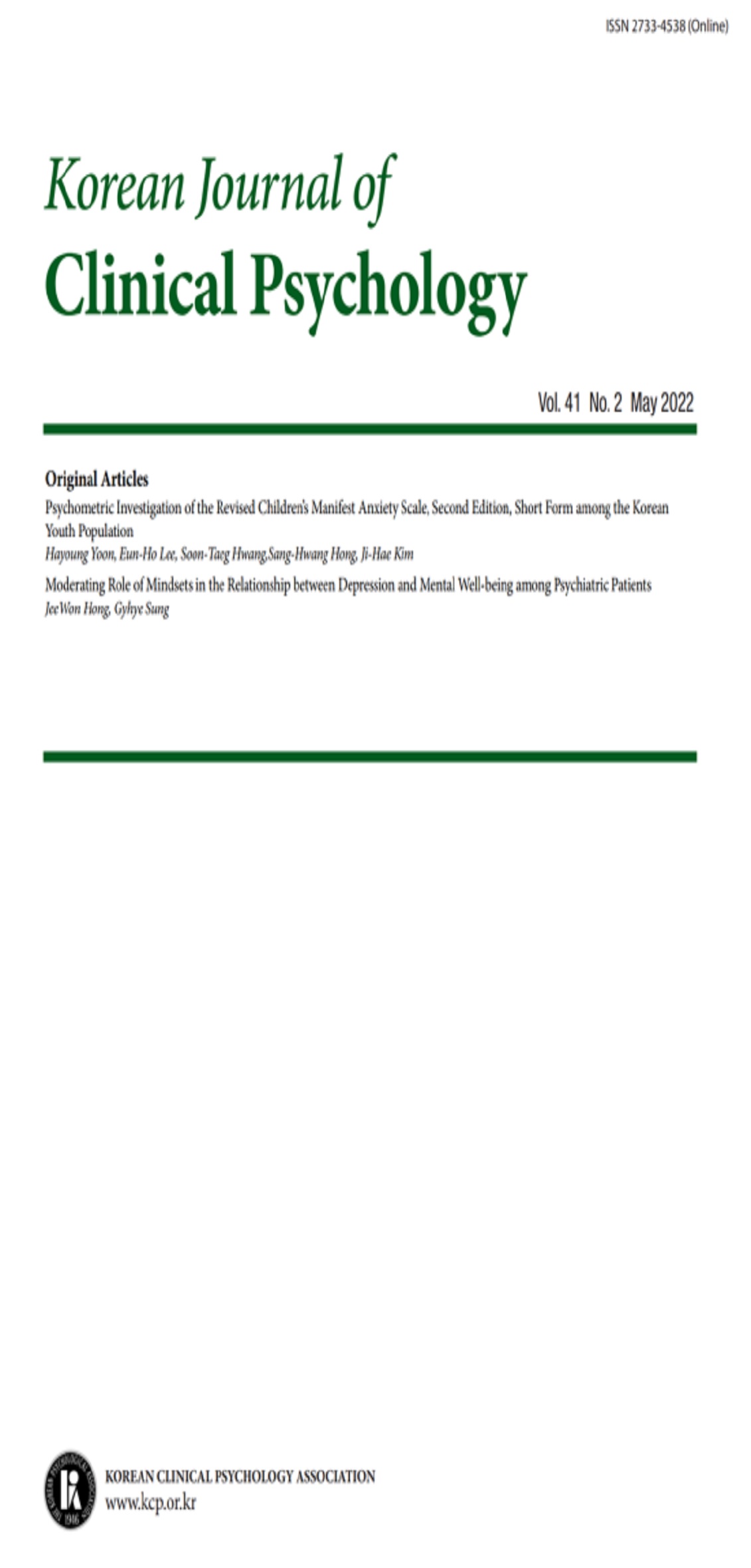open access
메뉴
open access
메뉴 E-ISSN : 2733-4538
E-ISSN : 2733-4538
본 연구는 자기불일치가 사회불안에 영향을 미치는 과정에서 자의식의 매개효과와 자기제시 동기의 중재효과를 확인해 볼 수 있는 하나의 모형을 검증해 보기 위한 것이다. 이를 위해 서울 소재 5개 대학의 대학생 853명의 설문 자료가 수집되었다. 수집된 자료는 구조방정식 모형을 통해 분석하였으며 나타난 결과는 다음과 같다. 첫째, 자의식의 매개역할을 가정한 모형과 가정하지 않은 몇 가지 대안 모형을 비교해 본 결과, 자기불일치와 사회불안과의 관계에서 자의식의 매개효과를 가정한 모형이 유의하게 더 좋은 적합도를 보였다. 둘째, 자기제시 동기가 높고 낮은 집단으로 나누어 자기제시 동기의 중재효과를 검증해 본 결과, 자기제시 동기가 높고 낮음에 따라 자기불일치에서 자기의식에 이르는 경로계수에 유의한 차이가 나타났다. 이러한 결과는 자기불일치와 사회불안 사이의 관계에서 자의식의 매개효과와 자기제시 동기의 중재 효과를 가정한 모형이 사회불안의 기제를 잘 설명해 줄 수 있다는 것을 시사한다. 이러한 결과를 바탕으로 본 연구의 시사점과 제한점에 관하여 논의하였다.
The purpose of this study was to explore the effects of self-discrepancy on social anxiety. A model proposed, included the mediator of the self-consciousness and the moderator of the self-presentation-motivation between self-discrepancy and social anxiety. Data from 853 undergraduate students were collected. For assessing self-discrepancy, multi-dimensional self discrepancy scale(MDSDS) was developed. Other scales were: self-consciousness, public self-consciousness sub-scale of Fenigstein's SCS scale, rumination sub -scale of maladaptive self-focued attention scale(MSFAS), social interaction anxiety scale(SIAS), social phobia scale(SPS), and self-presentation-motivation scale(SPMS). Data were analyzed through structural equational modeling. The model hypothesizing partial mediation effect of self-consciousness showed superior fit indices to other alternative models. And the path coefficient from self-discrepancy to self-consciousness indicated significant difference between high and low SPMS' which shows the moderating effect of self presentation motivation. Implications and limitations about theses results were discussed.
(2004) AMOS구조방정식 모형분석, 데이터솔루션
(1997) 대인불안 집단의 자기의식과 인정추구 요구,
(1999) 대인불안에 대한 자기 제시 동기와 자기 제시 기대의 관계,
(1991) 자기 초점화 주의가 불안에 미치는 영향,
(2000) 사회공포증 하위 유형의 기억 편향, 서울대학교 석사 학위 청구 논문
(2002) SPSS/AMOS에 의한 사회조사분석, 형설출판사
(2002) 사회불안 집단의 부정적 얼굴 표정에 대한 선택적 주의편파,
(1995) 자기-불일치와 심리적 불편감의 관계 자기 불일치 이론의 경험적 검증,
(1999) 사회공포증에 대한 인지적 평가3 역기능적 신념검사의 개발 및 타당화,
(2004) 다차원적 자기불일치 척도의 개발 및 타당화 연구,
(2004) ‘부적응적 자기초점화 척도’의 개발 및 타당화 연구,
(2000) 구조방정식 모형의 적합도 선정 기준과 그 근거,
(1995) Additive or interactive relation with social interaction Journal of Personality,
(1999) Type of self-discrepancy and relationships to components of the tripartite model of emotional distress,
(1989) Testing for the equivalence of factor covariance and mean structures the issue of partial measurement invariance,
(1995) A cognitive model of social phobia, Guilford Press
(1999) Interpretive biases for ambiguous stimuli in social anxiety,
(1960) A new scale of social desirability independent of psychopathology,
(1992) The British Journal of Social Psychology,
(1985) Individual differences in embarrassment,
(1987) Self-discrepancy:a theory relating self and affect,
(1985) A psychological model for distinguishing among different aspects of depression and anxiety,
(1988) Journal of Personality Assessment,
(1990185-302) Social anxiety and recall of interpersonal information Journal of Cognitive Psychotherapy,
(1995) The self-presentation model of social phobia, Guilford Press
(1997) Explicit and implicit memory bias in social phobia the role of subdiagnostic type,
(1988) Relationship between anxiety,
(1998) Development and validation of measure of social Phobia and Scrutiny and social interaction anxiety,
(1985) a revised version for use with the general population Journal of Applied Social Psychology,
(1993) Self- discrepancies in clinical anxious and depressive university students Journal of Abnormal Psychology,
(1998) Assessing measurement invariance in cross-national consumer research ,
(1993) Cognitive processes in social phobia,
(1989) Self-discrepancies in clinical depression and social phobia cognitive structures that underlie emotional disorders Journal of Abnormal Psychology,
(1998) Are shame and guilt related to distinct self-discrepancies A test of Higgins's ,
(2000) Cognitive processes in social anxiety the effect of self focus,
(1999) Self discrepancy in social phobia and dysthymia,
(2001) Brief cognitive therapy for social phobia,
(1997) Self focused attention in the treatment of social phobia,
